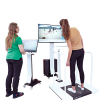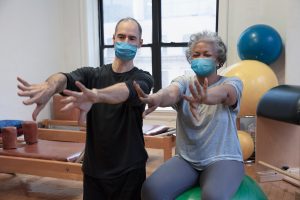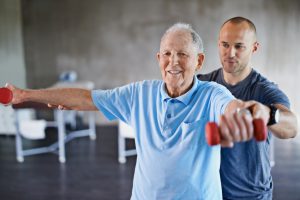
Five Essential Balance Assessments for Stroke Rehab
Treatment GuidelinesBalance assessments play a key role in gauging your stroke patient's fall risk, functional abilities, vestibular impairment, proprioception, and more. Read on for a breakdown of five essential balance assessments in stroke rehab: Romberg, Unterberger, Berg Balance Test, timed up and go, and functional reach test.
Balance assessments are important in most rehabilitation settings, but they play a particularly key role in stroke rehab. Balance assessment serves several different purposes, including indicating fall risk. In rehabilitation, the reimbursement for our services often depends on quantifiable and reliable outcome measures with our patients. Using balance assessments in stroke rehab, paired with technology to support our clinical findings, leads to more measurable progress and overall outcomes.
In this article, I’ll break down five key balance assessments in stroke rehab: the Romberg Test, Unterberger Test, Berg Balance Test, timed up and go (TUG), and functional reach test. Let’s dive in!
Balance After Stroke: Timing, Rehab, and Daily Function
It’s sufficient to say that balance is a key motor and vestibular skill necessary for safe daily functioning. Even subtle balance discrepancies, like those that occur when dual-tasking, can increase an individual’s risk of falling, injury, and potential hospitalization.1,2,3
In clinical practice, we know that reliable assessments are equally as important as early assessment in the rehab process. When using a reliable assessment, we can be that much more confident in the results and clinical correlation with performance, predicted outcomes, and course of care, and be able to accurately document such.4
Risk of Falls Dramatically Increases After Stroke
Neurological and cerebrovascular events dramatically increase the risk of falls by as much as 40% within the first year.3 Effects on the vestibular, musculoskeletal, and proprioceptive systems all contribute to an increased fear of falling, loss of independence (perceived or measured), and an increase in institutionalization.3 Balance itself is governed by many facets, including visual, vestibular, sensorimotor mechanisms, auditory, and higher-level premotor systems.4
The extent of functional limitations following a stroke depends on the severity of the incident, which areas of the brain are affected, and how quickly neurological rehabilitation can begin.5 As clinicians, we understand that our patients with severely hemiparetic or hemiparalytic limbs often have greater balance deficits. Across the board, however, rapid assessment post-stroke and systematic rehabilitation are vital for maximizing recovery in neurological and functional deficits like balance.5
Balance Assessments Used in Stroke Rehab
There are a few different ways to assess balance in a stroke rehab setting. One of the ones we use the most is clinical observation. While we clinicians are trained to be as objective as possible in our clinical observations, often, our own physiological makeup influences how we rate performance. For example, a partial assist for one person may be another’s maximal assist in certain situations. While we rate performance throughout our therapy sessions and can gather a general functional trend, we still need to pursue reliable and objective assessment data to accurately track progress.
Clinical Technology Identifies Small Changes More Accurately
Using technology for objective measurement allows us to measure, quantify, and report patient progress with the highest degree of accuracy and reliability. Today’s advanced devices such as force plates, balance platforms, and motion analysis systems are becoming both accessible and integrated into clinical neurorehabilitation practices.9,10 In recent years, this measurement technology has also proven to be very sensitive to incremental changes in balance in a subacute rehab setting.9,10 Using advanced clinical tools can exponentially increase the accuracy of how we approach balance deficits in stroke rehab, thus providing the best care to our patients.
1. Romberg Test
The Romberg Test is a standardized balance assessment used by physical and occupational therapists to identify posterior columnal deficits of the spinal cord.11 Originally developed to study tertiary syphilis effects, the Romberg test (and accompanying positive/negative Romberg sign) gauges the proprioception status between the visual and vestibular systems.11 This element makes the Romberg useful in patients with ataxia, incoordination, post-neurological events, Parkinson’s disease, and Wernicke’s syndrome.11
To conduct a Romberg test, a therapist will instruct their patient to stand with both feet together, without shoes. Two stages follow this stance as follows:
- With eyes open, instruct the patient to either stand with their hands and arms at their side, or with their arms crossed in front of their body. As a therapist, you’ll be observing for paradoxical sway, loss of balance, or other movement relative to balance.11
- In the second stage, instruct the patient to close their eyes while holding the same position from stage 1 for a one-minute duration11. Be extra prepared to catch your patient at this stage! Some swaying may be observed and indicate normal vestibular accommodation; however, any increase in postural sway, loss of balance (including self-correction by moving foot position) .11
A positive Romberg sign can clinically indicate unilateral or bilateral vestibular dysfunction, loss of proprioception in sensorimotor pathways, or pathologies involving specific anterior cerebellar lobe structures, specifically by denoting sensory ataxia as a root cause11. These clinical indications allow us to structure our interventions systematically to address vestibular function.
Romberg Test Performed with Alfa
Performing the Romberg balance assessment with objective measurement technology makes your evaluation more accurate, precise, and reliable. The Alfa stabliometric platform by BTE allows effortless merging of balance training and objective balance assessments, including the Romberg. During a Romberg balance assessment, Alfa tracks even slight changes in the patient’s center of pressure, exact direction and severity of sway, and any changes in postural stability, all quantified and displayed in real time.
After the baseline balance assessment, you can compare results with later follow up evaluations to show patient progress over time. With the Alfa’s objective measurement, this assessment can indicate gait disturbance, abnormal proprioception, gait disturbance, and the degree of disequilibrium caused by vertigo and head trauma.12 The quantifiable measurements are also valuable to include in your documentation; any extra bolster we can have for insurance and to assess functional progress is a welcome addition.
2. Unterberger Test
Our second balance assessment for stroke rehab is the Unterberger test. Also known as the Fukuda Stepping Test (FST), it is similar to the Romberg in that it measures vestibular dysfunction.13 The main difference is that the Unterberger is conducted through ambulation.13 Due to the nature of this assessment, the Unterberger is not appropriate for non-ambulatory patients or those with significant hemiparesis.
As physical and occupational therapists, we administer this test by instructing our patients to step or march in place at a comfortable cadence. With eyed closed, the patient’s goal is not to turn while stepping.14 Unilateral vestibular hypofunction will cause the patient to turn when the visual somatosensory system is taken out of the equation. A turn greater than 45 degrees indicates a positive result and indication for dysfunction with the high likelihood of leading to falls.14
Data-Driven Unterberger Test with Alfa
Like the Romberg, the Unterberger/FST can be performed with Alfa to determine specific disturbances of the vestibular system with quantified metrics. The Alfa system tracks postural sway, rotation, and movement when stepping in place with high sensitivity. Both the angular deviation and the deviation along the X-Y axis are calculated automatically.
In vision-occluded marching, a person’s degree of rotation can be very subtle and hard to identify by observation alone. Measuring with the Alfa provides highly sensitive and precisely quantified tracking with easy-to-understand reports. These results can be tracked consistently and compared throughout a patient’s rehabilitation timeline.
3. Berg Balance Test
The Berg Balance Test is one of the most common balance assessments used in physical and occupational therapy. It’s used across populations, including those with strokes, orthopedic injuries, and spinal cord injuries.
I use the Berg Balance Test fairly frequently with my patients in inpatient rehab. It takes about 15 minutes to administer and consists of 14 tasks, such as sitting unsupported and a sit-to-stand.15 The scoring criteria is very straightforward, as I rate each task individually. The lower the score, the more hands-on assistance a patient needs, and the greater risk of falls if attempting to move independently.15
Unlike the Romberg and Utenberger tests, the Berg test doesn’t have a technological component. As a balance assessment, it does have high inter-rater reliability, which means different clinical professionals performing the test should get the same results. However, it lacks the sensitivity of the more advanced clinical tests and cannot distinguish what type of balance problem is affecting the patient.4
4. Timed Up and Go (TUG) Test
The Timed Up and Go (TUG) Test is another common assessment in stroke rehab. It’s simple and quick to administer and correlates with other assessments like the Berg test.4 To perform the TUG you’ll need a stop-watch. Starting from a seated position, the patient will walk three meters, turn around, walk back to the chair, and sit down. If they longer than 13.5 seconds to complete the TUG, they are at an increased risk for falls.4 Your patient should complete the TUG without physical assistance, but devices like canes and walkers are allowed.
I usually reserve this test for my ambulatory patients. While TUG is widely used and accepted, it does have some limitations. It is a fairly targeted test that only measures one functional task, and it cannot determine what balance deficits are occurring to affect the patient’s performance.4
5. Functional Reach Test
The Functional Reach Test is another quick and easy screening that has very good validity in predicting fall risk.4 All you need is a pen and a way to mark a starting point and an ending point. Have your patient sit upright in a chair (I like to put them parallel to a wall), then have them hold out their arm closest to the wall at 90 degrees of shoulder flexion. I mark where their fingertips lie on a piece of paper taped onto the wall; this will be my starting point. Then, have them reach as far forward as they can past this point. A reach outside this base equal to or less than six inches is considered at risk for falls.4 Like others, the Functional Reach Test is a good indicator of fall risk but it lacks sensitivity and insight into what systems are at play after an injury that increases that risk.4
Conclusion
Stroke rehabilitation outcomes are time-sensitive. Early and accurate assessment leads to the best outcomes for our patients, and the assessments we use to measure performance should reflect that same need.
Using advanced clinical technology in our balance assessments generates objective data that provides the best insight into the patient’s condition. Balance systems like Alfa give your evaluations the highest degree of clinical accuracy so you can confidently diagnose and address balance-related issues.
Mary Vieregge, OTR/L is an Occupational Therapist and freelance writer based in Eastern North Carolina. She has experience in a range of settings, from inpatient rehabilitation to long-term care, with a concentration in neurorehabilitation and spinal cord injury populations. Mary is passionate about patient education and innovative practices, is constantly searching for the latest and greatest to add to her clinical toolbox, and enjoys connecting over LinkedIn or UpWork.






